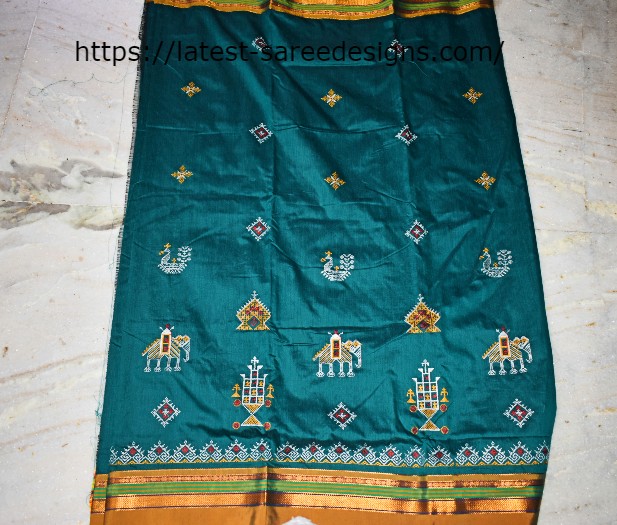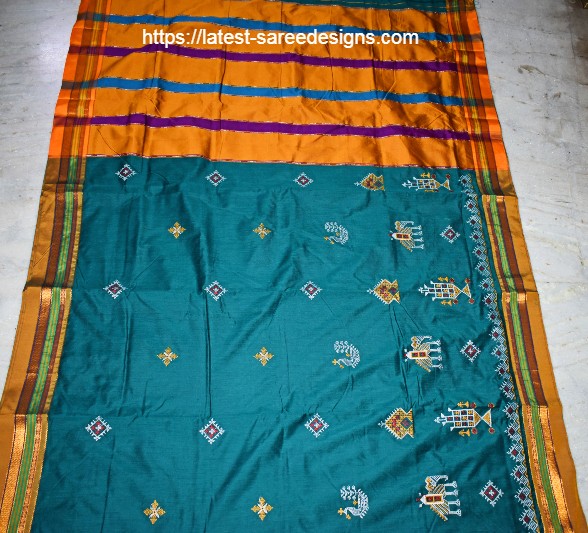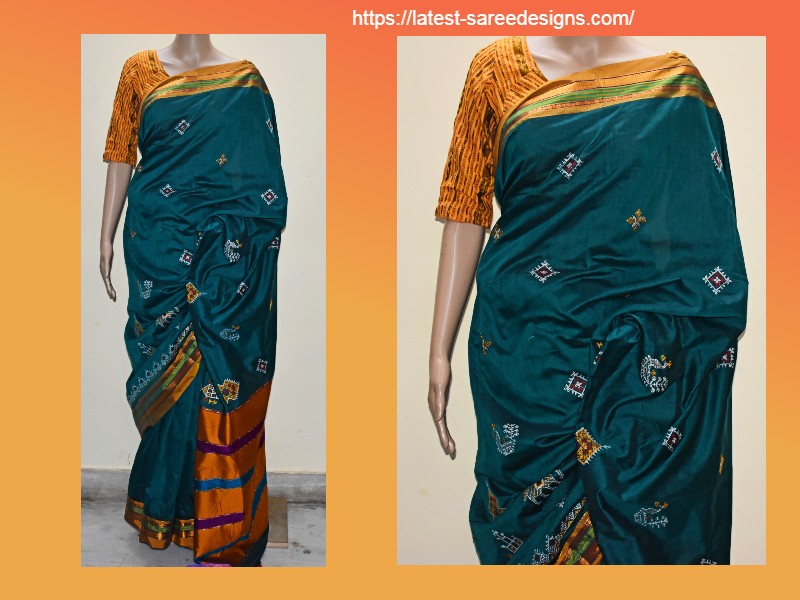This is an Ilkal Kasuti saree. That is Kasuti embroidery made on an Ilkal saree.
Kasuti is an embroidery mainly from Karnataka.Originating from the state’s northern districts like Dharwad and Bijapur, Kasuti embroidery is renowned for its intricate patterns, vibrant colors, and deeply rooted symbolism. Steeped in history and tradition, this art form continues to captivate artisans and enthusiasts alike with its timeless beauty and meticulous craftsmanship.
This is not the the hand embroidered one, the Kasuti mbroidery is done with machine.

The saree has different kinds of Kasuti embroidery motifs.
There are several kinds of motifs in Kasuti embroidery
- Gopura (Temple Tower): Symbolizing spirituality and divine blessings, the Gopura motif represents the towering spires of Hindu temples. It often features geometric patterns reminiscent of temple architecture, showcasing the artisan’s reverence for religious symbols.
- Elephant and Peacock: Elephants and peacocks are frequently depicted in Kasuti embroidery, symbolizing beauty, grace, and strength. These majestic creatures are intricately stitched with fine details, adding a regal touch to the fabric.
- Chariot (Ratha): The Chariot motif symbolizes fertility and prosperity, drawing inspiration from ancient mythology and folklore. It typically features a chariot adorned with decorative elements, conveying a sense of abundance and auspiciousness.
- Lotus Flower: The lotus flower holds deep cultural significance in Indian traditions, symbolizing purity, enlightenment, and rebirth. Kasuti embroidery often incorporates delicate lotus motifs, showcasing the artisan’s skill in creating intricate floral patterns.
- Conch Shell (Shankha): Representing purity and auspiciousness, the conch shell motif is a common sight in Kasuti embroidery. Its spiraling form adds a sense of movement and vitality to the fabric, evoking a sense of divine presence.
- Peacock Feather: Peacock feathers are celebrated for their vibrant colors and intricate patterns, making them a popular motif in Kasuti embroidery. The elegant curvature of the feathers is meticulously stitched, creating a mesmerizing visual effect.
- Mango (Aam): The mango motif symbolizes fertility, prosperity, and the sweetness of life. Its distinctive shape and intricate detailing make it a favorite among artisans, often adorning the borders of sarees and other garments.
- Floral Patterns: Kasuti embroidery features a wide array of floral motifs, ranging from simple blooms to elaborate bouquets. These motifs draw inspiration from local flora and fauna, showcasing the artisan’s connection to nature.
- Geometric Shapes: Alongside representational motifs, Kasuti embroidery also incorporates geometric shapes such as triangles, squares, and diamonds. These patterns add a sense of symmetry and balance to the design, enhancing its visual appeal.
Here is the close view of the motifs on the pallu side:

Ilkal Kasuti sarees always look elegant whatever the occassion. This suits the casual as well as for functions. This is how it looks when worn:
